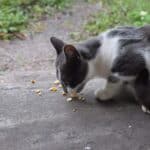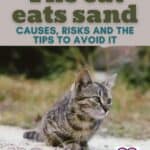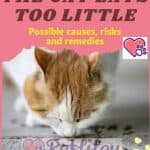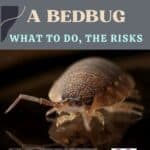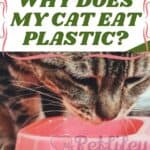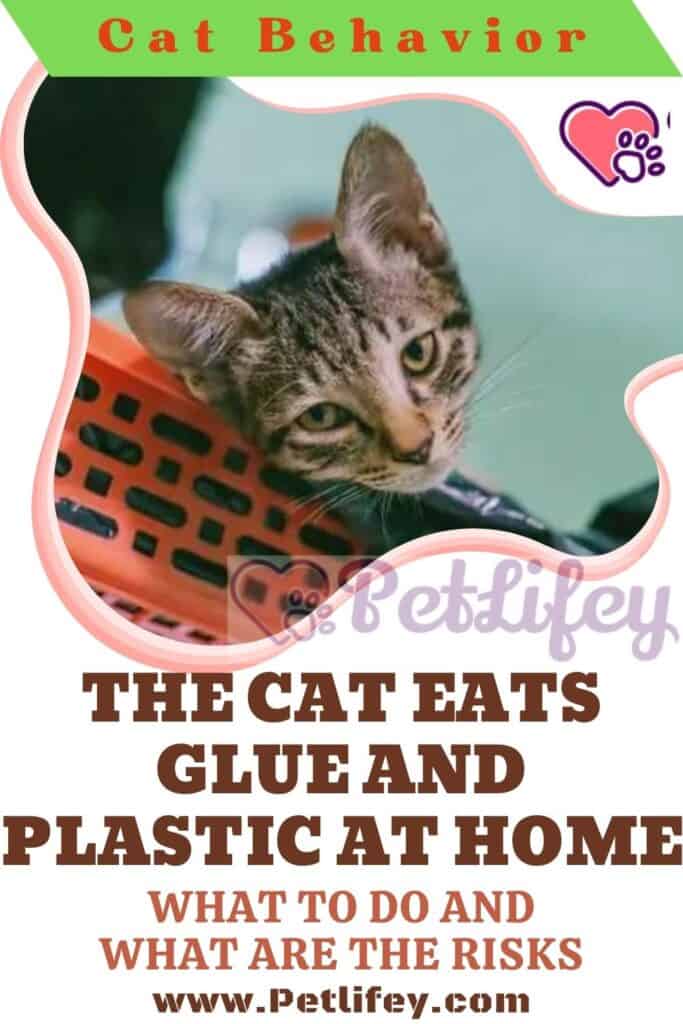
Many cats have a bad habit of tasting and chewing objects and substances that are harmful to their health at home. Why Does My Cat Eat Glue, Plastic, or Duct Tape?
Many cats love scotch or duct tape. They love it in the sense that they lick and eat it if they find it around. Others like to eat plastic or glue. Obviously the best solution to avoid these problems is to keep any objects out of reach of the cat, if it can be a danger to him / her. But since these items are made up of harmful chemicals that are certainly not healthy if ingested, are there any dangers if the cat eats glue, tape or plastic? And why does he do it, is there a reason behind this really bizarre behavior?
Why Cats Love Duct Tape and Glue
Many cat owners report that their kitty really loves duct tape. You can not lose sight of the tape if it is within reach of the “paw”, which the cat takes it and begins to bite and lick it. But the same goes for glue, adhesives, plastic: all substances certainly not beneficial for the health of the cat. But what is the real reason why cats are attracted to these objects, certainly not appetizing for us humans?
Why cats eat glue and duct tape in particular is unclear: A plausible explanation is that cats simply have different preferences among themselves when it comes to smells or textures that attract them. A possible cause from which this sort of addiction can start is instead pica (or allotriophagy), a condition for which an animal eats inedible objects.
Cats can develop pica if they are weaned too early. They develop the habit of sucking on inedible objects, such as wool or other fabrics, and more extreme cases may involve the consumption of objects such as plastic (or glue and tape). Here are some other possible causes for cat pica:
- Cat health problems – Eating something unusual could be a sign of a deeper health problem, such as feline leukemia, feline immunodeficiency virus, brain tumors, or diabetes. It could also be a sign of dietary problems, such as anemia or something missing from the cat’s diet.
- Genetics – Pica may also be just a genetic trait. For example, wool sucking is most commonly found in cats of the Burmese and Siamese breeds. It could also be a sign of compulsive disorder.
- Boredom – Some cats may start gnawing on unusual household items simply out of boredom , or to get their owner’s attention. These cats may need more stimulation in their environment.
The reasons why cats eat glue and duct tape can really be many and different, and it is always good to have a medical check-up with our vet, especially if it is a habit that develops suddenly.
Puppy cats that are teething are more likely to experiment with new items than adult cats and this is completely normal. Puppies lose their baby teeth and grow a full set of adult teeth between 3.5 and 7 months. Different teeth will fall out at different times, but the urge to chew may be stronger during these 4 months, and as the kitten tries to get relief from the 30 new teeth that are coming.
Cats, as kittens, love to have fun playing with small objects (for example balls, rubber bands, bottle caps also made of cork) and sometimes they simply – like children – put them in their mouths. Once they learn about the consistency of these objects, they often continue to have this habit and continue to search for similar objects throughout their lives.
Cats that have problems with aggression may start chewing strips of plastic and other items around the house in an attempt to express their emotions. These aggressive behaviors can be a sign of pain, poor socialization, and stress, among other things.
Problems with chewing plastic
Some plastic items are absolutely acceptable for our cat, but many others pose a potential danger to this feline. Plastic items that are small enough to fit fully into your mouth pose a choking hazard. They could also be ingested and cause other problems.
Plastic items can cause blockages, and prevent food and water from passing through the body, or puncture and / or tear the stomach or intestines if the object has sharp edges or angles. If the cat consumes plastic, it will need to be removed .
Sometimes the vet will recommend making the item vomit, but this is not the case with all plastic items. More often than not, the vet performs surgery or endoscopy to remove the object from the cat. These procedures require general anesthesia and are not without risk, so it’s always best to stop your cat from eating plastic in the first place.
Is eating glue dangerous? How to prevent it?
In a word, yes. The problem is the possibility of intestinal blockage. Cats often throw up things they can’t digest, but not always, and a case of intestinal blockage because the cat ingested a piece of duct tape could be dangerous and require complex veterinary intervention.
Again, the first step should be to speak to a vet to make sure the cat doesn’t show any signs of health problems, but we can focus on keeping the cat away from glue and similar items. Here are some suggestions:
- We keep adhesive objects away: we do our best to keep glue or other objects out of our cat’s reach. For example, don’t leave them in the room when we use them or work! We try to use other options, such as ribbons to tie, whenever possible.
- Aversion to taste: Another way is to eliminate attraction to the adhesive by training the cat to associate it with a taste it does not like, such as something bitter. We let the kitty smell and taste even these items, then leave out a piece or two of tape coated with this bitter taste. We keep putting some of this substance on glue or duct tape every time we use them around the house, and hopefully, the kitty will start to associate bad taste with them.
- Increase the stimulation: If the cat is chewing the tape because he is bored, let’s try to spend a little more time playing with him / her, or create more stimulation in their environment, such as nice views from the windows, videos or games for cats.
- Diversion: Let’s just give the cat something else to chew on! If we find it with glue or duct tape, we try to distract it with something safe, like a toy with a surprise inside.
Of course, we can ask our vet or an animal behaviorist for more advice for more information on how to deal with a cat with this problem.
The dangers of super glue
Super glue is an object often found in our homes and offices. Super glue is not one of the most dangerous poisons for animals, but cats can have contact with this substance, and therefore owners often ask themselves about its toxicity.
Cats of all ages, races and sexes can be exposed, both because they are attracted to the smell of glue (this is why cats eat glue, but it is not the only reason as we have said), but also because of the contact on the fur. In fact, cats are more frequently exposed because they can find glue on their fur, and subsequently lick it during grooming. The most common problem associated with glue ingestion is mild oral irritation.
What to look for? The signs will depend on which part of the body is exposed and can include:
- Deburring
- Shaking of the head
- Put your paws in your mouth
- Cough, choking
- Gagging and vomiting
- Lack of appetite (anorexia)
- Strabismus, eye palpitation, tearing, red eyes ( in case of eye exposure )
- Presence of dry glue on fur, paws, ears, eyes, etc.
Diagnosing super glue ingestion – if we haven’t seen it firsthand – can be difficult. If the animal vomits, we may have difficulty finding traces of glue, as they may be clear and impossible to see, but we may notice a typical smell of glue.
Upon closer inspection, we may notice a certain chemical smell in the cat’s breath or skin, or even just see some glue on its fur. The irritation is usually in the mouth area, or in the throat. In these cases, it is best to have blood tests (with a complete blood count and biochemical profile) if the cat appears depressed and is vomiting.
How to treat the cat if it has swallowed the glue
Most glue exposures require no treatment, and the marks are generally mild. But foreign bodies in the gastrointestinal tract are possible if the tube itself is ingested, which is relatively rare in cats.
If only a small amount of glue has been ingested, no treatment is required. The important thing is to keep the cat calm and quiet to prevent vomiting. Treatment and recommendations may vary, depending on the area of the body where the contact occurred.
In case of ocular exposure, care may include rinsing the eye with saline or water. If the eyelashes stick to the skin and cause eye irritation, parting under sedation may be necessary. Damage to the cornea (corneal ulcerations) is treated with topical medications.
For cases of skin exposure, care may include trimming the hair with a nail clipper to remove the glue. A part of the very superficial glue, on the tips of the hairs, could be removed even with just a good combing or brushing. For glue that is in a clustered form, it might help to loosen the glue bond.
To help loosen the bond, you can soak the area in warm, soapy water. Acetone, often found in nail polish remover, usually dissolves the glue bond without damaging the skin. Apply small amounts of acetone with a cotton ball and gently peel off the skin.
Margarine, petroleum jelly and / or mineral oil can be used like acetone to dissolve glue and separate tissues. Usually just apply these products, and in about 20-30 minutes they will work. Then just gently massage the area to remove the traces. We must never force the tissues to separate, or the skin may tear. Tissues can be separated under sedation if necessary.
If you apply products, gently wash the area with soap and water when finished. Most adherent fabrics will separate in about 1-3 and a half days. There may be a small residue of glue on the skin which may be difficult to remove.
In many cases, it is a matter of skin losing its top layer, which will allow for complete removal of the glue. In the event of a slight exposure to the skin or coat, we may consider leaving it that way. Many times the products and action used to remove the glue are more traumatic for the cat than the glue itself.
In the case of exposure to the ear, this can be problematic as the glue can stick to the eardrum. Sometimes, the bond with the glue can be loosened by gently applying 3% hydrogen peroxide or acetone with a cotton ball. This should be followed by an ear wash with sterile water or saline.
In any case, it is best to call your vet for his recommendations before trying any treatments at home. All exposures to the ears and eyes must be evaluated by your veterinarian and there is no need to intervene in person if you are not an expert.
Prevent the cat from chewing plastic
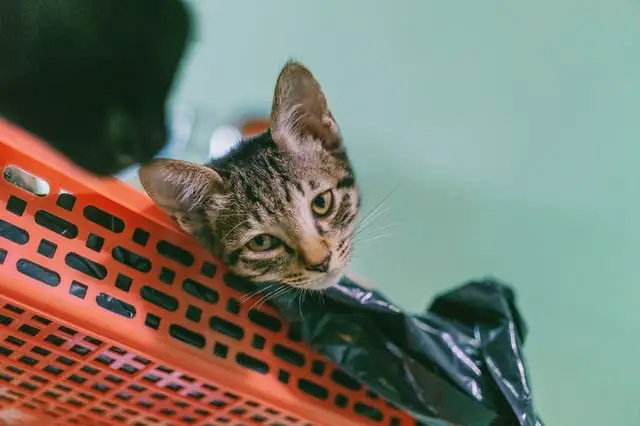
Stress and anxiety can be reduced and sometimes prevented in cats. Pheromones can help a cat relax in a new environment or where changes are occurring, medications can relieve severe anxiety, and supplements can help relax a kitten naturally.
By helping to prevent or reduce the amount of stress our cat experiences, we hope to reduce the likelihood of them getting into the bad habit of chewing on plastic, glue, and other harmful items. Allowing our indoor cat to slowly adapt to new things, avoiding the sight of cats outdoors by closing the curtains or blinds, and other techniques can also help avoid stressing our kitty.
It may go without saying, but by collecting and disposing of plastic items such as rubber bands, plastic lids, and other dangerous items that are within reach of a cat, we will completely prevent the cat from getting on its paws. If we don’t want our cat to chew on an object, we try to hide or eliminate it.
Finally, a great way to keep a cat disinterested in plastic items is to attract them to items that aren’t plastic. We provide our four-legged friend with fun and safe toys of different textures and fabrics, using feather wands and laser pointers to entertain him and using catnip or other treats to lure him to other objects we want him to play with or chew on.


